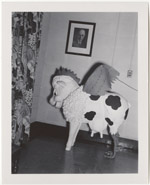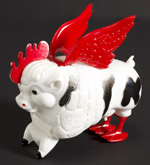Cornell’s Animal Celebrities:
The “Unimal”
The Unimal was the invention of Cornell Professor Howard E. Babcock (1889-1950). Babcock, who taught in the College of Agriculture and Life Sciences, believed that using animal products could contribute to a healthier diet as well as provide farmers with a stronger market for their products. In an effort to show the importance of animal agriculture and its commodities, the Unimal draws together five different animals, the cow, steer, pig, sheep, and chicken. A plaster version appeared at the annual Farm and Home Week exhibit in the Cornell School of Nutrition in Savage Hall, but it also traveled across the U.S. with visits to St. Louis and Washington, D.C. The Unimal even became a plastic toy, created to help teach children the value of animal agriculture and proper nutrition. Press down the head of this 1951 toy, and an animal product will pop out from underneath. Each press produces a different item: a bottle of milk, a pound of butter, a hotdog, a ham, or an egg.
 |
“Unimal” plaster model. March 1950 at Cornell Farm and Home Week. [zoom] | Additional images: 
|
 |
“Unimal” toy. [zoom] | Additional images:  
|
YouTube Video: “The Unimal: Five Animals Rolled into One” | |